Star Swarm, DirectX 12 AMD APU Performance Preview
by Ryan Smith & Ian Cutress on February 13, 2015 10:00 AM EST- Posted in
- GPUs
- AMD
- Microsoft
- APUs
- DirectX 12

After several requests and a week’s break from our initial DirectX 12 article, we’re back again with an investigation into Star Swarm DirectX 12 performance scaling on AMD APUs. As our initial article was run on various Intel CPU configurations, this time we’re going to take a look at how performance scales on AMD’s Kaveri APUs, including whether DX12 is much help for the iGPU, and if it can help equalize the single-threaded performance gap been Kaveri and Intel’s Core i3 family.
To keep things simple, this time we’re running everything on either the iGPU or a GeForce GTX 770. Last week we saw how quickly the GPU becomes the bottleneck under Star Swarm when using the DirectX 12 rendering path, and how difficult it is to shift that back to the CPU. And as a reminder, this is an early driver on an early OS running an early DirectX 12 application, so everything here is subject to change.
| CPU: | AMD A10-7800 AMD A8-7600 Intel i3-4330 |
| Motherboard: | GIGABYTE F2A88X-UP4 for AMD ASUS Maximus VII Impact for Intel |
| Power Supply: | Rosewill Silent Night 500W Platinum |
| Hard Disk: | OCZ Vertex 3 256GB OS SSD |
| Memory: | G.Skill 2x4GB DDR3-2133 9-11-10 for AMD G.Skill 2x4GB DDR3-1866 9-10-9 at 1600 for Intel |
| Video Cards: | MSI GTX 770 Lightning AMD APU iGPU |
| Video Drivers: | NVIDIA Release 349.56 Beta AMD Catalyst 15.200 Beta |
| OS: | Windows 10 Technical Preview 2 (Build 9926) |
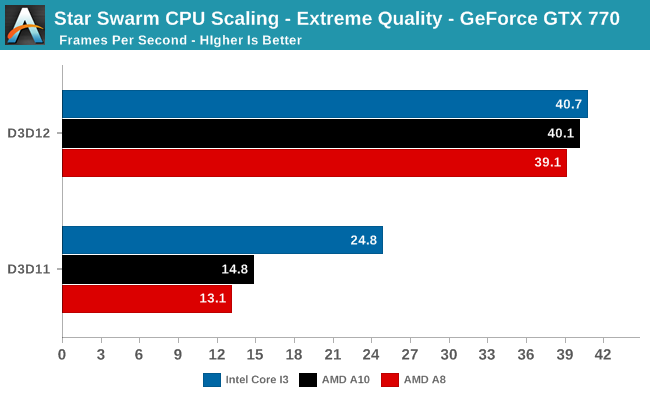
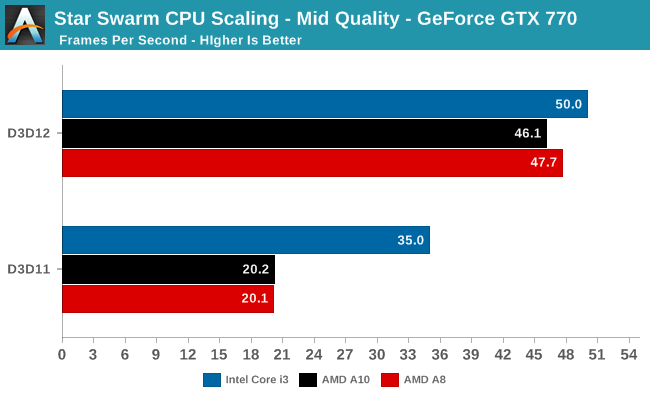
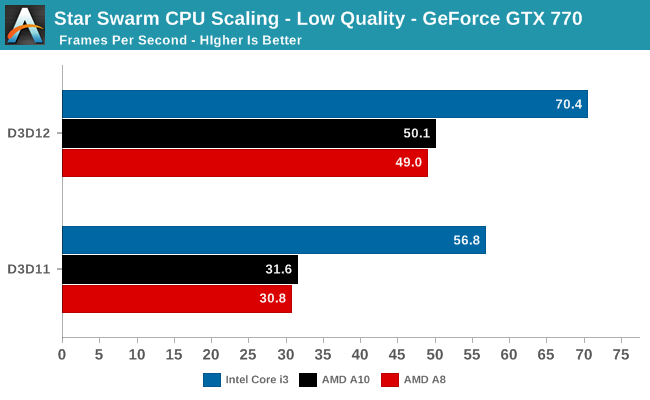
To get right down to business then, are AMD’s APUs able to shift the performance bottleneck on to the GPU under DirectX 12? The short answer is yes. Highlighting just how bad the single-threaded performance disparity between Intel and AMD can be under DirectX 11, what is a clear 50%+ lead for the Core i3 with Extreme and Mid qualities becomes a dead heat as all 3 CPUs are able to keep the GPU fully fed. DirectX 12 provides just the kick that the AMD APU setups need to overcome DirectX 11’s CPU submission bottleneck and push it on to the GPU. Consequently at Extreme quality we see a 64% performance increase for the Core i3, but a 170%+ performance increase for the AMD APUs.
The one exception to this is Low quality mode, where the Core i3 retains its lead. Though initially unexpected, examining the batch count differences between Low and Mid qualities gives us a solid explanation as to what’s going on: low pushes relatively few batches. With Extreme quality pushing average batch counts of 90K and Mid pushing 55K, average batch counts under Low are only 20K. With this relatively low batch count the benefits of DirectX 12 are still present but diminished, leading to the CPU no longer choking on batch submission and the bottleneck shifting elsewhere (likely the simulation itself).
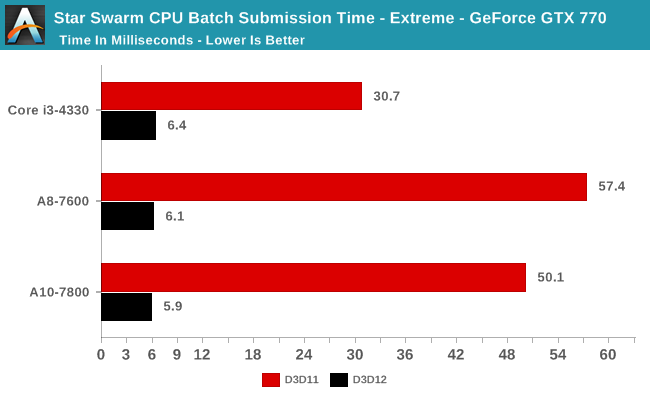
Meanwhile batch submission times are consistent between all 3 CPUs, with everyone dropping down from 30ms+ to around 6ms. The fact that AMD no longer lags Intel in batch submission times at this point is very important for AMD, as it means they’re not struggling with individual thread performance nearly as much under DirectX 12 as they were DirectX 11.
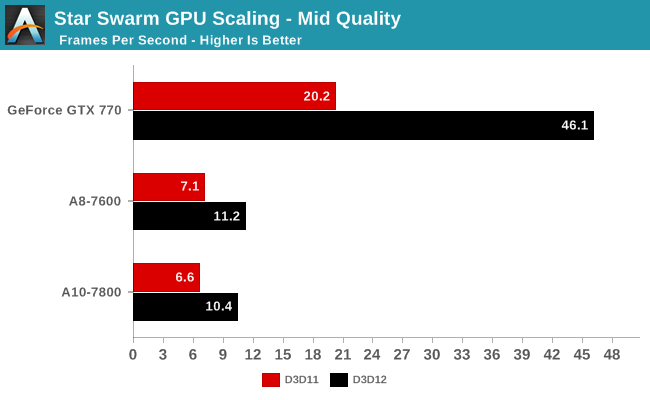

Finally, taking a look at how performance scales with our GPUs, the results are unsurprising but none the less positive for AMD. Aside from the GTX 770 – which has the most GPU headroom to spare in the first place – both AMD APUs still see significant performance gains from DirectX 12 despite running into a very quick GPU bottleneck. This simple API switch is still enough to get another 44% out of the A10-7800 and 25% out of the A8-7600. So although DirectX 12 is not going to bring the same kind of massive performance improvements to iGPUs that we’ve seen with dGPUs, in extreme cases such as this it still can be highly beneficial. And this still comes without some of the potential fringe benefits of the API, such as shifting the TDP balance from CPU to GPU in TDP-constrained mobile devices.
Looking at the overall picture, just as with our initial article it’s important not to read too much into these results right now. Star Swarm is first and foremost a best case scenario and demonstration for the batch submission benefits of DirectX 12. And though games will still benefit from DirectX 12, they are unlikely to benefit quite as greatly as they do here, thanks in part to the much greater share of non-rendering tasks a CPU would be burdened with in a real game (simulation, AI, audio, etc.).
But with that in mind, our results from bottlenecking AMD’s APUs point to a clear conclusion. Thanks to DirectX 12’s greatly improved threading capabilities, the new API can greatly close the gap between Intel and AMD CPUs. At least so long as you’re bottlenecking at batch submission.










152 Comments
View All Comments
Andrew LB - Friday, February 13, 2015 - link
Star Swarm is a demo/benchmark tool that was made by Oxide for AMD and is highly tuned specifically to AMD architecture, specifically their APU's. It focuses far too much on specific memory operations and not a wide variety of GPU workloads that would be be comparable to the kind of work a GPU does while running games. to be honest I don't think this can be called a benchmark tool and instead should be called a AMD Marketing Tool.HighTech4US - Saturday, February 14, 2015 - link
Not a very good Marketing Tool if it makes AMD's APU IGP's look like crap on DX12.Th-z - Saturday, February 14, 2015 - link
Oh really, explain why it's specifically tuned for AMD arch, what numbers support your claim, and what specific memory operations, and why does a CPU test, mainly to stress API draw calls need wide variety of GPU workloads.HighTech4US - Thursday, February 26, 2015 - link
Quote: It's not a game, you know?It is being used in games, you know?
http://www.anandtech.com/show/8962/the-directx-12-...
Quote: It should be noted that while Star Swarm itself is a synthetic benchmark, the underlying Nitrous engine is relevant and is being used in multiple upcoming games. Stardock is using the Nitrous engine for their forthcoming Star Control game, and Oxide is using the engine for their own game, set to be announced at GDC 2015. So although Star Swarm is still a best case scenario, many of its lessons will be applicable to these future games.
But with AMD IGPs having frame rates of 11 for Mid Quality settings we can see that AMD IGPs will be utterly useless for any of those games.
okp247 - Friday, February 13, 2015 - link
Cheers for the follow up, guys. Much appreciated!One little thing: maybe next time pair the APUs up with at least DDR3-2133 when doing iGPU-tests?
K_Space - Friday, February 13, 2015 - link
+1Ian Cutress - Friday, February 13, 2015 - link
Apologies, there was a miscommunication on my part. I did specifically run the APUs (and Intel) at their maximum supported frequency defined by the manufacturer, so in this case it means the AMDs were at 2133 and the i3 was at 1600. I've updated the configuration table.okp247 - Friday, February 13, 2015 - link
Ah, good job. Thanks.SaberKOG91 - Friday, February 13, 2015 - link
What, no Mantle comparison? I'm disappointed.Ian Cutress - Friday, February 13, 2015 - link
With the drivers required for DX12, for whatever reason the Mantle version of Star Swarm did not seem to initiate. This may be a driver flag or something similar not enabling the APU integrated graphics to engage Mantle. Of course it's all a work in progress still. No GTX 770 + Mantle numbers, obviously.